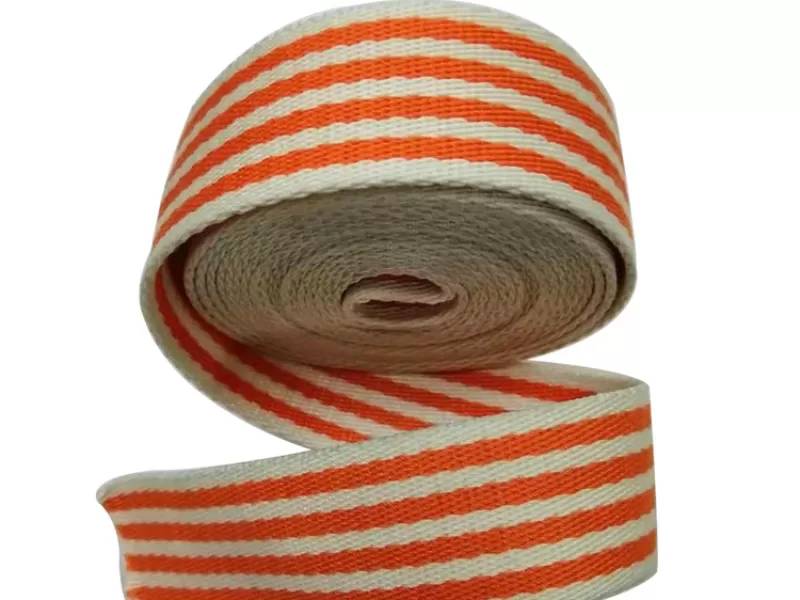What is cotton-like webbing? Analysis of materials and characteristics - A in-depth comparison of the differences from pure cotton webbing

In the fields of luggage, clothing, household items, etc., "ribbon" is an important auxiliary material, and the choice of its material directly affects the performance of the product and the user experience. Among them, "cotton-like ribbon" and "pure cotton ribbon" are often confused due to their similar names, but there are significant differences between the two in terms of materials, characteristics, and uses. This article will analyze the definition, materials, and core differences between cotton-like ribbon and pure cotton ribbon to help users accurately select the appropriate type of ribbon.
I. What is cotton-like ribbon?
Cotton-like ribbon is a chemical fiber ribbon that simulates the characteristics of natural cotton through chemical processes. It does not actually contain cotton but uses man-made fibers (such as viscose fiber, polyester fiber, etc.) as raw materials and is processed through special techniques to make its appearance and feel similar to pure cotton ribbon.
- Material composition**: The main components of cotton-like ribbon include cellulose or protein-based polymer compounds (such as cotton-type viscose staple fiber), which are made through chemical processing.
- **Performance characteristics:
- High gloss: The surface is flat and free of impurities, with a more beautiful visual effect.
- Low cost: Due to its chemical fiber raw materials, the price is usually lower than that of pure cotton ribbon.
- Prone to pilling: Pilling may occur after long-term use, especially in scenarios with frequent friction.
II. Five core differences between cotton-like ribbon and pure cotton ribbon
1. Raw material differences
- **Cotton-like ribbon**: It is mainly made of man-made fibers such as viscose fiber and polyester, belonging to chemically synthesized materials.
- **Pure cotton ribbon**: It is made of natural cotton fibers, with a cotton content of over 75%, being environmentally friendly and skin-friendly.
2. Physical property comparison
- **Moisture absorption and comfort**: Pure cotton ribbon has stronger moisture absorption (with a moisture content of 8% - 10%), is soft and breathable when in contact with the skin, and is suitable for close-fitting use. Cotton-like ribbon has poor moisture absorption, but the comfort of some chemical fiber materials can be improved through process optimization.
- **Strength and durability**: Pure cotton ribbon can still maintain high strength in a humid environment and is not easy to break. When the cotton-like ribbon gets wet, the fiber strength decreases, and it is easy to break when stretched.
3. **Combustion identification method**
The two can be quickly distinguished through combustion:
- Pure cotton ribbon**: It burns rapidly with a bright flame, the ash is fine and grayish-white, and the smell is similar to that of burning paper.
- **Cotton-like ribbon**: When burning, there may be black smoke and a pungent chemical smell (for example, polyester burns with a sweet smell, and nylon has a celery-like smell).
4. Application scenarios
- **Cotton-like ribbon**: It is mostly used for fillers or decorative auxiliary materials that do not directly contact the skin, such as linings of low - priced clothing and the inner layers of luggage.
- **Pure cotton ribbon**: It is suitable for high - demand close - fitting products, such as baby products, shoulder straps of high - end clothing, and environmentally friendly backpacks.
5. Environmental protection and price
- **Environmental friendliness**: Pure cotton is a natural degradable material, while the environmental friendliness of cotton-like ribbon needs to be judged according to the type of chemical fiber (for example, PP ribbon has better environmental friendliness).
- **Price**: Due to its low raw material cost, cotton-like ribbon is usually 30% - 50% cheaper than pure cotton ribbon.
III. How to choose cotton-like or pure cotton ribbon?
- **Pursuing cost - effectiveness**: Choose cotton-like ribbon, which is suitable for scenarios with limited budgets and low requirements for durability.
- **Emphasizing health and comfort**: Give priority to pure cotton ribbon, especially in fields such as母婴 (should be "maternity and baby") and close - fitting clothing.
- **Special functional requirements**: If functions such as waterproofing and antistatic are required, cotton-like ribbon with improved chemical fibers (such as polypropylene ribbon) can be considered.
Conclusion
Both cotton-like ribbon and pure cotton ribbon have their own advantages and disadvantages. When choosing, it is necessary to combine specific uses, budgets, and environmental protection requirements. Whether it is luggage customization or clothing accessories, understanding the core differences between the two can help users make more informed decisions. If you need to further understand ribbon materials or customization services, you can refer to the technical materials of professional ribbon manufacturers or directly consult the manufacturers.